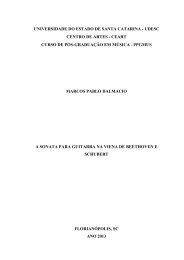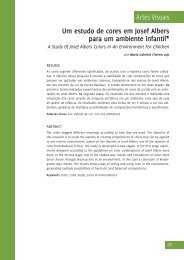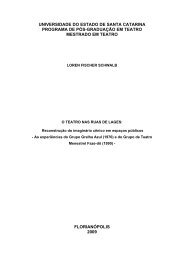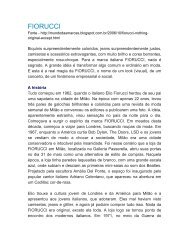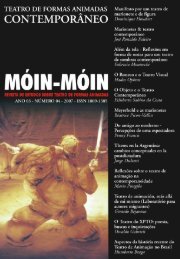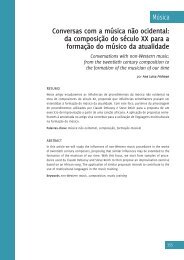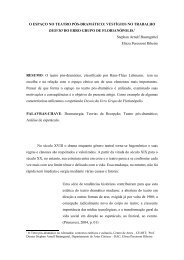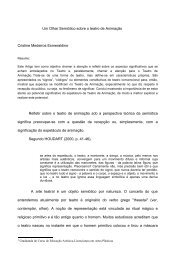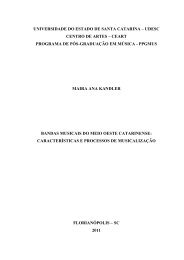Edição e distribuição www.designeditora.com.br Tipologia Adobe ...
Edição e distribuição www.designeditora.com.br Tipologia Adobe ...
Edição e distribuição www.designeditora.com.br Tipologia Adobe ...
You also want an ePaper? Increase the reach of your titles
YUMPU automatically turns print PDFs into web optimized ePapers that Google loves.
180<<strong>br</strong> />
Revista de Estudos so<strong>br</strong>e Teatro de Formas Animadas<<strong>br</strong> />
MÓIN-MÓIN<<strong>br</strong> />
in his shows”. 2 In fact, Lepage’s theatricality is in between various media, from<<strong>br</strong> />
traditional (photography, slides, and puppetry) to contemporary (digital video<<strong>br</strong> />
and robotics). In Lepage’s theatricality, multimedia and new technology are yet<<strong>br</strong> />
another creative stimuli, resources for the performers to devise their stories. In<<strong>br</strong> />
his productions recorded visual and sound images allow the intervention of live<<strong>br</strong> />
action in a symbiotic way connecting man and a machine. This might suggest<<strong>br</strong> />
that Lepage is engaged with theatricality built on <strong>com</strong>plex visual images and<<strong>br</strong> />
technological matrices. This is untrue. It would be a mistake to think of Lepage<<strong>br</strong> />
as solely a techno wizard, whose work is about sensationalistic manipulation of<<strong>br</strong> />
new technologies, employing expensive digital equipment that will ultimately<<strong>br</strong> />
go against the live performer.<<strong>br</strong> />
Lepage’s theatricality functions within the <strong>com</strong>bination of live and<<strong>br</strong> />
recorded imagery, it is a <strong>com</strong>munication between performers and all the<<strong>br</strong> />
technology invited into the space, where in Johannes Barringer’s terms, ‘spatial<<strong>br</strong> />
perceptions are made through what is physically introduced into space.’ 3<<strong>br</strong> />
Technology is also, as Alison Oddey observes, contributing to the process of<<strong>br</strong> />
creation in devised theatre and influencing the development of the performance<<strong>br</strong> />
in its evolution. 4 Lepage likes to relate to technology at the same level as to the<<strong>br</strong> />
written text (when there is one), and performers’ creativity. This collage of live<<strong>br</strong> />
and recorded could be referred to as techno-en-scene, or technology that is in<<strong>br</strong> />
symbiosis with performer’s action in space. Indeed, Lepage’s techno –en-scene<<strong>br</strong> />
is hy<strong>br</strong>id theatricality that <strong>com</strong>bines live performance with cinematic imagery,<<strong>br</strong> />
video and slide projections, and collaborations with digital technologies and<<strong>br</strong> />
artists from various disciplines.<<strong>br</strong> />
Historically Lepage’s theatricality sits in the tradition of Adolphe Appia’s<<strong>br</strong> />
‘total theatre’. At the turn of the 20 th century, Appia elaborated the idea of ‘total<<strong>br</strong> />
theatre, and in fact foreshadowing multidisciplinary theatre, he claimed that<<strong>br</strong> />
theatre is the only art form that can <strong>br</strong>ing together other art forms: text (music<<strong>br</strong> />
or speech), stage setting (the sculptural or painting), and theatre (architecture).<<strong>br</strong> />
Similarly to Appia, Edward Gordon Craig’s idea of total theatre refers to the<<strong>br</strong> />
independent and equal use of all theatre elements that have to be precisely<<strong>br</strong> />
employed on stage. This requires a ‘master’ artist to edit from the outside<<strong>br</strong> />
these elements. Because the performer can not be separated from his personal<<strong>br</strong> />
imperfections, the artistic precision demanded by Craig is only possible if the<<strong>br</strong> />
‘body’ remains an inner aspect of the performance while it is controlled from<<strong>br</strong> />
the outside by the director as master puppeteer of a ‘technical body’ within the<<strong>br</strong> />
2 Lavender, Hamlet in Pieces, 6.<<strong>br</strong> />
3 Birringer, Theatre, Theory, Postmodernism , 31.<<strong>br</strong> />
4 Oddey, Devising Theatre.



